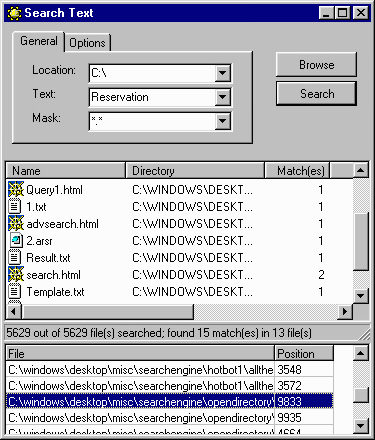
Search Text
The Search Text function allows you to find any/all files that contain specific word(s) or phrases.
PLEASE NOTE: UE even offers the capability to search for specific text contained in files within compressed files such as Zip, Cab, Tar, and the like. See the How Do I? - Work With Archives section.

The Search Text dialog box has both a General and Options tab. Results from your search are displayed in the bottom windows.
General - Location: Clicking on the drop-down arrow to the right of this box will show all local and mapped drives. You can choose a specific drive or use the Browse button to choose a more specific folder or subfolder.
General - Text: This is where you enter the specific word, phrase, or any text you are searching for. The drop-down arrow will contain any previous search words you have used since UE has been open for the current session.
Genral - Mask: You can refine your search to specific files by using a Mask. The *.* as shown above means any and all files. The * is used as a wildcard so *.doc would limit the search to only Word Documents while contract.* would limit the search to only files named contract but that may have different extensions such as .txt, .rtf, .htm, .wps, etc.
Options Tab: You can use these options to further refine or expand your search.
Recurse subfolders: Check this box to search subfolders on a drive or within a parent directory or folder. If you selected C:\All Websites on the General Location - and you DID NOT have this option checked - the search would be limited to the root directory of C:\All Websites and all subfolders under this one would not be searched.
Include All Drives: Selecting this option will conduct the search on all available drives (either local or mapped via a network).
First Entry Only: Selecting this option will stop the search after the first matching file is found.
Case Sensitive: Selecting this option means the target text must match what you entered on the General Text line ExAcTLy.
Once a search is complete, the matching files will be displayed in the middle window. You can double click on these files to launch them into their native application. When expanded this window will show the following data about each file:
Name, Directory, Match(es)-the number of times the target is contained in the file, File Size, File Type, Modified Date
The bottom window will show the same files. However, this screen shows the full file path to each file and the exact position the first instance of the target string was found. You can select a file by single-clicking on it. If you double-click on a file in this screen, it will be launched into the UE Text Editor window and the first instance of the target string will be highlighted.